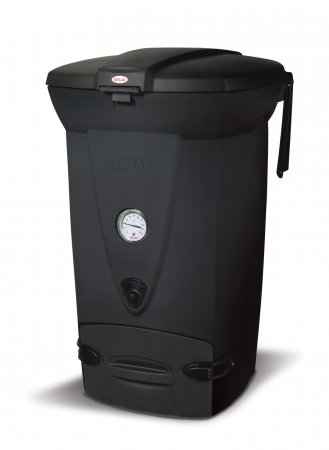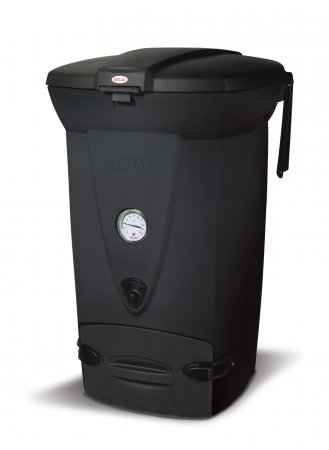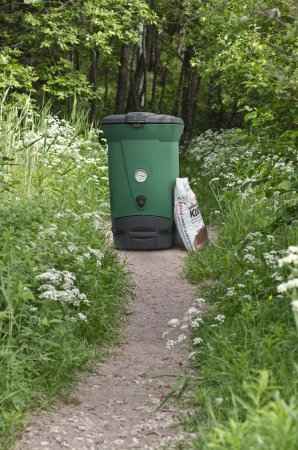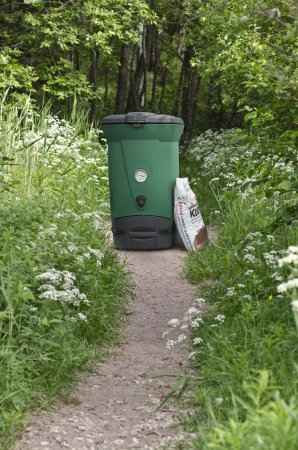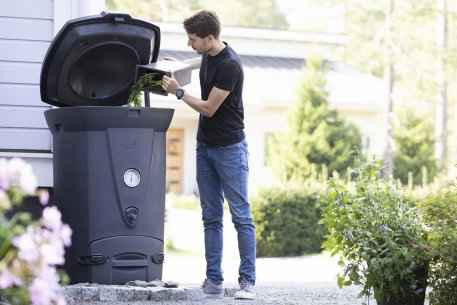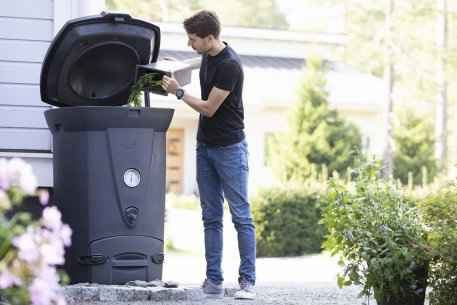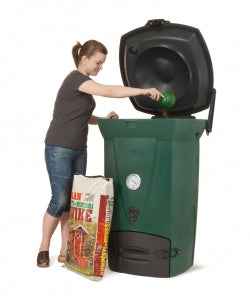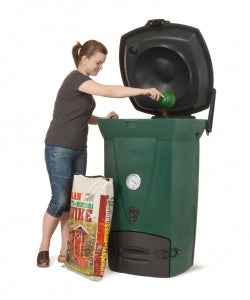Biolan Ultimate Biowaste 220 Composter
Questions about this product
Questions about this product
Delivery and shipping
Delivery and shipping
Orders are typically processed within 1 to 2 business days from the time of purchase, excluding holidays and weekends.
Shipping times and cost will vary depending on the product and your location.
On average:
Ontario and Quebec: 2 to 5 business days
Western Canada: 4 to 7 business days
Atlantic provinces: 4 to 8 business days
Northern or remote areas: Contact us to confirm
-
-
Even more ecological!
- the ultimate in composting bio-waste year round
- for 1-6 persons
- use with Biolan Bulking Material
- latching lid with rubber seal
- temperature gage in Celsius
- adjustable valve for ventilation
- patented ventilation system
- efficient thermal insulation, also at the bottom
- the shape of cover returns the condensed moisture to the compost mass
- dense structure that prevents harmful animals from entering
- efficiently composts household biowaste
- collects the seep liquid
- thermally insulated construction
- odorless use
- easy-to-clean surfaces
- convenient emptying
- long emptying interval
- manufactured in a factory that is powered by wind and solar energy
Please note: This product must be shipped by freight on a pallet. Please call for quote.
The Biolan Ultimate Biowaste 220 Composter is designed for the ultimate in year-round composting of kitchen scraps, toilet waste and dog poop. The thermally insulated composter with an patented adjustable ventilation system, keeps the heat naturally generated in the composting process, to be retained in the the composter allowing the the compost material to breakdown quicker than a regular composter. The Biolan Ultimate Biowaste 220 composter will continue to compost even during the winter when standard composters stop working. With 30% more insulation than our Biowaste composter and our patented ventilation system, the Biolan Ultimate Biowaste 220 Composter is the best year round composter on the market. The Biolan Ultimate Biowaste 220 Composter has also been sized to handle the biowaste generated by a single family. If Biolan Ultimate Biowaste 220 Composter is used in the correct manner, the bio mass will be efficiently composted, which will make using and unloading of the composter more pleasant.
You can put all kinds of food scraps into a composter, such as human waste, apple cores, banana peels, vegetable skins, coffee grounds, eggshells, and bread. However, animal products, such as meat, dairy, and bones, generally aren’t recommended for composting because they can harbor pathogens and attract pests.
You also can add grass clippings, leaves, wood shavings, hay, animal manure, and other yard waste, as well as paper towels, cardboard, and shredded newspaper. “You should avoid grease and oils as they can cause the compost to become waterlogged,” says Phillips. “Anything containing chemicals, such as treated wood and synthetic fertilizers, should also not be added to the compost.” You should also avoid adding weeds to your pile, if your home regularly faces high temperatures, as they can regrow in your pile.
The composter is intended for biodegradable materials only. Do not place anything in the composter that could impede the composting process or will not turn into compost, such as:
- Plastic, rubber, glass, leather
- Chemicals, wood preservatives and disinfectants, paints, solvents, petrol
- Detergents, washing water
- Lime
- Ash, cigarette butts, matches
- Vacuum bags
- Coloured advertisement paper
- Large quantities of paper
Choosing correct composter location
Place the Biolan Ultimate Biowaste 220 Composter in a place where you can easily take your waste and unload the composter all year round. Set the composter up on a firm surface at a location with good drainage. Make sure that the composter is level.
Draining off the seep liquid
The Biolan Ultimate Biowaste 220 Composter includes a seep liquid opening in the bottom left-hand side to drain any excess liquid. The amount of seep liquid from the Biolan Composter is small, depending on use. The seep liquid, however, is extremely rich in nutrients and is also an excellent fertilizer. Place the composter directly onto the ground so that the soil will absorb any seep liquid. It can also be collected in the container to be used to fertilize planters and other potted plants. If the compost mass is unusually wet, seep liquid may also seep from under the unloading door and from the inlet air valve at the front of the composter.
Before use
Place the liquid separation plate in the recess located in the bottom of the composter (the seep liquid drain). The purpose of the liquid separation plate is to separate any excess liquid from the compost mass. The plate can be detached and cleaned if necessary.
The Biowaste Composter has a seep liquid opening in the bottom left-hand side to allow any excess liquid to drain from the composter and be absorbed into the ground. You can collect the seep liquid in a container if you like, but this is not mandatory. Remove the rodent shield from the seep liquid opening in the bottom edge of the composter with a screwdriver, for example. Connect a liquid hose, diameter 32 mm, to the seep liquid opening in the bottom edge of the composter. Place the other end of the hose in a container located in such a place that the liquid will flow downhill.
Place a layer of five centimeters (5 cm) of Biolan Bulking Material in the bottom of the composter. Start using the composter. When you are putting waste into the composter for the first time, use more bulking material than recommended – you can reduce the amount later on.
Filling
- Empty your household container into the composter. Please note that the larger the pieces of waste you put into the composter, the longer it will take for them to disintegrate.
- If you use biodegradable rubbish bags, empty the content of the bag into the composter and put the bag in separately.
- Always cover the waste with Biolan Bulking Material. Usually the proper amount is approximately one-third to half of the amount of new waste deposited in the composter. If the waste is wet, use more of the bulking material.
- Continue adding more waste to the composter as you generate more waste. Try to add more waste to the composter several times a week. This is especially important during the cold season.
- Stir in the most recent compost down to some 20–30 cm from the surface. You do not need to mix the compost after every loading. The more bulking agent you use, the less mixing the mass requires.
- Do not mix the entire compost mass all the way down to the bottom to prevent the already cooled lowermost layers from cooling down the compost mass that is still warm.
Unloading
- The Biolan Ultimate Biowaste 220 Composter must be emptied all year round. Unload the composter when it is almost full, more often during the cold season than during the warm season. After the composter has been unloaded, there is more oxygen in it, which will often increase the temperature inside the composter.
- In the wintertime, only remove a little bit of the compost mass at a time. In the summertime, you can remove more, but always unload at the most half of the compost mass.
- Open the unloading door (part 5) and remove some of the mass from the bottom of the composter with a shovel.
- Also clean the area under the seep liquid plate and make sure that there is no blockage in the seep liquid hose.
- If the mass you removed was very wet, place a couple of shovelfuls of Biolan Bulking Material in the bottom of the composter.
- Close the unloading door.
- Press down the mass from the top with the shovel, for example. It will be easier if you start from the corners. Take care not to damage the inlet air channel located in the centre of the composter.
- Empty the seep liquid container, if necessary.
Winter use
The heat in the composter is generated by combustion of the waste. The unit itself does not create any heat. The micro-organisms continuously need fresh waste for maintenance of their vital functions. The thermal insulation of the Biolan Ultimate Biowaste 220 Composter prevents the heat from escaping, and thus sustains the operation.
- in the cold time of the year it is important to use the composter, i.e. to fill and empty it. Only then can such conditions be created for the micro-organisms that they will be able to maintain a temperature that is higher than the outside air temperature.
- even if the reading of the temperature gauge drops to zero or close to it, do not stop using the composter.
- even if the composter’s temperature gauge has been at zero for a few days, there may still be some unfrozen mass inside the composter. If the composter is full, empty it even in the winter.
- do not reduce or stop the use of bedding even in the cold time of the year; using plenty of bedding is even more important then. Wet mass freezes more easily.
- store the bedding in a warm space, protected against rain.
- check that freezing of the air inlet or the air outlet valves will not impede the circulation of air. Remove any ice as needed.
- freezing of the mass does not harm the compost mass or damage the composter or its components. The decomposition of the compost mass will continue once the sun starts warming things up again in spring.
If you plan to use the composter in winter, make sure that the drain hose and the seep liquid canister do not freeze.
Cleaning the Biolan Ultimate Biowaste 220 Composter
- Do not wash the composter. Various mould, fungi and micro-organisms are the decomposers in the compost, and should not be washed away.
- Clean the air inlet valve, the air outlet opening and the seep liquid hose, if necessary.
Using the air inlet valve
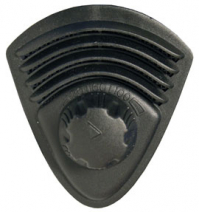
- if the temperature of the composter is higher than the temperature of the outside air, keep the adjuster of the inlet air valve turned to the right, i.e. in the position 100.
- follow the temperature of the composter and the outside air. If the compost mass starts cooling down, decrease the setting until the temperature stabilizes.
- during the warm season, you can generally keep the air inlet valve fully open, i.e. in the position 100, and during the cold season, almost closed, i.e. in the position 20.
- by design the air inlet valve can never be fully closed. In the position 20, 20 % of its holes are open.
Using the air outlet valve
- normally, the air outlet valve does not need to be adjusted. It is open, and cannot be closed at all. If the moisture-content of the composter is high, you can increase the ventilation by opening the valve.
- to open the valve, move its knob to the position “extra”, i.e. to the right, seen from behind the composter.
- note that the intensified ventilation may cool down the composter in winter. Follow the situation.
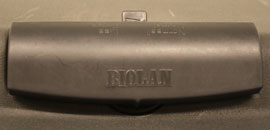
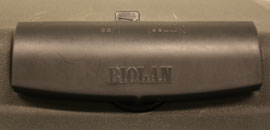
Specifications
- Volume: about 220 litres
- Height: 115 cm
- Bottom area: 54 x 54 cm
- Cover (w x l): 73 x 80 cm
- Diameter of the seep liquid hole: 16 mm
- Weight of the cover when opening: 3,5 kg
- Weight of an empty composter: about 30 kg
- Weight of a full composter: 100 – 150 kg
- Working height: 102 cm
- Material: frost-resistant UV-protected polyethylene
- Insulation material: freon-free polyurethane
- Ventilation: adjustable, patented
- Other items: thermometer
- Optional colours: dark grey
To serve our customers across Canada, whether you're in a major city or completely off the grid, many of our products are shipped via freight delivery to ensure safe and efficient transport. Depending on your location and the item, you’ll have the option to pick up from a nearby warehouse terminal or request home delivery.
Free Terminal Pickup on Most Large Items
Most large items we sell, including appliances, solar kits, and other freight-shipped products, include free shipping to your closest warehouse terminal.
Your order will be delivered to the nearest terminal based on your location, where you can pick it up at your convenience.
Need it delivered to your home or cabin? We can set that up for you. There is a small additional fee for residential delivery.
Remote and Hard-to-Reach Locations
If you live in a remote area or outside standard freight zones, please contact us before placing your order.
Some rural locations may require additional charges or special delivery arrangements. We'll confirm everything with our freight partner before shipping.
Local Pickup Options Across Canada
We work with warehouse terminals in every province, so many of our products can be picked up locally to save on shipping costs.
Not all items are eligible, so if you're unsure at checkout, give us a call or send us an email and we'll confirm the best option for your area.
Shipping Times and Order Processing
Orders are typically processed within 1 to 3 business days from the time of purchase, excluding holidays and weekends.
Shipping times will vary depending on the product and your location. On average:
- Ontario and Quebec: 2 to 5 business days
- Western Canada: 4 to 7 business days
- Atlantic provinces: 4 to 8 business days
- Northern or remote areas: Contact us to confirm
We will provide tracking details when available once your order has shipped.
Receiving Freight Shipments
For large freight deliveries, you will receive a call from the carrier or your nearest terminal when your order is ready for pickup or delivery.
Important: Always inspect your shipment before signing any paperwork.
If the box or pallet is damaged:
- Do not sign the Bill of Lading (BOL) as "received in good condition"
- Instead, note the damage clearly on the BOL
- Or refuse the shipment if damage is significant
If no damage is recorded and the shipment is accepted, the freight carrier will consider it delivered in perfect condition. In that case, we cannot issue a refund or replacement. This is a strict freight carrier policy and applies to all deliveries.
Damaged or Missing Items
If there’s an issue with your shipment (whether it’s damage, missing parts, or anything unusual) please contact us within 48 hours of receiving the item. Be sure to include photos whenever possible, as these are often required to file a freight claim on your behalf. If the item was shipped to a terminal, it must be picked up within 48 hours or a $45/day storage fee will apply.
We have a 30-day return policy, which means you have 30 days after receiving your item to request a return.
To be eligible for a return, your item must be in the same condition that you received it, unused, with tags, and in its original packaging. You’ll also need the receipt or proof of purchase. Shipping costs back to Canadian Off Grid are the responsibility of the customer and 15% restocking fee will apply.
To start a return, you can contact us atryan@canadianoffgriddepot.com. If your return is accepted, we’ll contact you to discuss options, as well as instructions on how and where to return your item. Items sent back to us without first requesting a return will not be accepted.
Payment & Security
Payment methods
Your payment information is processed securely. We do not store credit card details nor have access to your credit card information.







